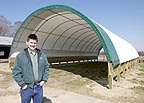March 29, 2005
Hoop houses may help small hog producers

Caption follows story
Apgar, a Southern Illinois University Carbondale agriculture professor whose license plate reads “PIG GUY,”is looking at hoop houses, a cheap, portable, environmentally sound and animal-friendly way of housing hogs that could help the state’s small-time producers compete with mega-farms raising thousands of porkers.
Hoop houses look a lot like those temporary greenhouses that grocery and discount stores put out in the parking lot when garden season rolls around. A typical house, measuring 30 feet by 72 feet, consists of two parallel, 4-foot-high walls topped by a series of steel hoops and covered with a plastic tarp. It has feeding and watering stations inside and gates at each end to keep the animals in.
“There are no pens,” Apgar said. “It’s an interactive environment where they’re all in one giant group.”
A hoop house holds about 180 pigs at a “per-pig space” cost of $50 to $60, compared to the $180 to $200 “per-pig space” cost of typical confinement barns. While a hoop house does require a fair bit of bedding material, most farmers would have the necessary straw and cornstalks readily at hand. And used bedding material can be recycled as compost.
In fact, a hoop house is actually a little compost factory. The pigs lay down the manure and urine layer, the farmer adds a layer of bedding, the pigs add another layer of waste, and…well, you get the picture.
Composting cuts down on odors and generates heat.
“In the winter, that’s what keeps the pigs warm because you don’t have environmental controls,” Apgar said.
With all these plusses, you figure there have to be a few minuses, and there are. Researchers have found that pigs in hoop houses have more backfat, smaller loins and are all around less lean than those raised in confinement barns. In the summer, hoop-raised pigs gain weight faster than confinement hogs, but in winter they don’t do as well.
However, said Apgar, there’s a very big “But” attached to these findings.
“All of that data comes from places like Australia, Canada, the upper Midwest,” he noted. “There’s no information on the usefulness of these housing systems in a more southerly environment.
“And much of the published research on hoop structures has focused on engineering principles and not on normal production agriculture concepts. There’s been no effort to alter the diets offered to these animals to overcome the performance reductions of housing pigs in an environment lacking environmental controls.”
Apgar plans to do just that. SIUC’s first hoop house will let him look at how adding dietary fiber might help the pigs stoke up their body furnaces to counteract those winter-related feed efficiency losses. And because additional fiber should cut feed costs, the savings there might help offset any losses in weight gain.
He’s also teaming up with agriculture colleague Dwight R. Sanders, an economist, to compare hoop houses with confinement barns to see which style has a better rate of investment return.
If he can come up with the money to put up three more houses, Apgar will be able to test the effects of diets specifically designed to help hoop-raised pigs pack on the (lean) pounds as well as their more portly, confinement-raised counterparts do.
Noting that Illinois hog farms housing fewer than a thousand pigs have declined by nearly two-thirds since 1993, Apgar said he hopes this project might generate some interest in low-cost, sustainable housing.
“I think this could improve the number of livestock producers in the state,” he said.
Leading in research, scholarly and creative activities is among the goals of Southern at 150: Building Excellence Through Commitment, the blueprint for the development of the University by the time it celebrates its 150th anniversary in 2019.
